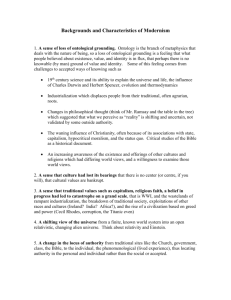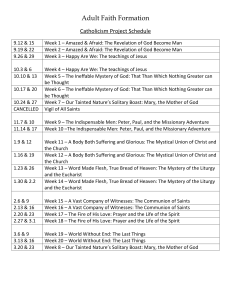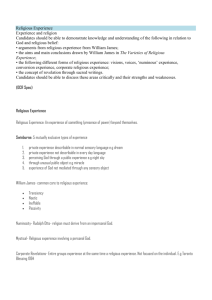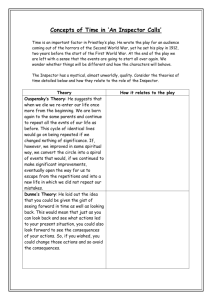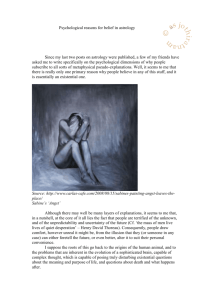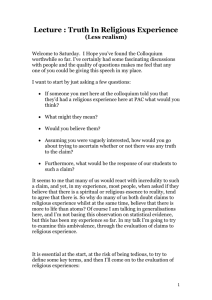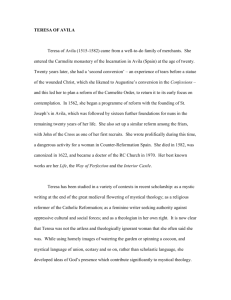Can Mystical Experience be a Source of Knowledge
advertisement
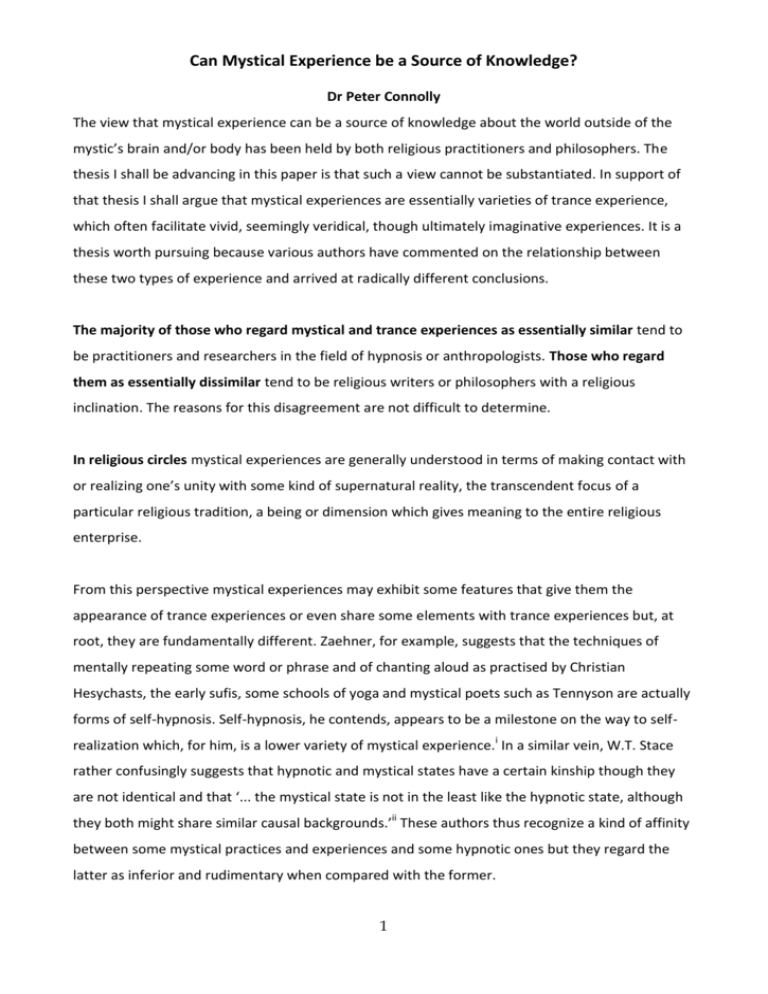
Can Mystical Experience be a Source of Knowledge? Dr Peter Connolly The view that mystical experience can be a source of knowledge about the world outside of the mystic’s brain and/or body has been held by both religious practitioners and philosophers. The thesis I shall be advancing in this paper is that such a view cannot be substantiated. In support of that thesis I shall argue that mystical experiences are essentially varieties of trance experience, which often facilitate vivid, seemingly veridical, though ultimately imaginative experiences. It is a thesis worth pursuing because various authors have commented on the relationship between these two types of experience and arrived at radically different conclusions. The majority of those who regard mystical and trance experiences as essentially similar tend to be practitioners and researchers in the field of hypnosis or anthropologists. Those who regard them as essentially dissimilar tend to be religious writers or philosophers with a religious inclination. The reasons for this disagreement are not difficult to determine. In religious circles mystical experiences are generally understood in terms of making contact with or realizing one’s unity with some kind of supernatural reality, the transcendent focus of a particular religious tradition, a being or dimension which gives meaning to the entire religious enterprise. From this perspective mystical experiences may exhibit some features that give them the appearance of trance experiences or even share some elements with trance experiences but, at root, they are fundamentally different. Zaehner, for example, suggests that the techniques of mentally repeating some word or phrase and of chanting aloud as practised by Christian Hesychasts, the early sufis, some schools of yoga and mystical poets such as Tennyson are actually forms of self-hypnosis. Self-hypnosis, he contends, appears to be a milestone on the way to selfrealization which, for him, is a lower variety of mystical experience.i In a similar vein, W.T. Stace rather confusingly suggests that hypnotic and mystical states have a certain kinship though they are not identical and that ‘... the mystical state is not in the least like the hypnotic state, although they both might share similar causal backgrounds.’ii These authors thus recognize a kind of affinity between some mystical practices and experiences and some hypnotic ones but they regard the latter as inferior and rudimentary when compared with the former. 1 From the perspective of much hypnosis research the contents of mystical experiences tend to be regarded as cultural or religious constructs that are experienced vividly because they are encountered whilst in a state of trance. Kroger, for example, argues that prayer and meditation are essentially autohypnotic techniques, citing the researches of Bowers and Glasner (1958), Das (1963), Gastaut (1969) and Walrath and Hamilton (1975) in support.iii Morse et al compared hypnosis and meditation and found no significant differences between them on a range of physiological measures,iv whilst Sacerdote claims to be able to induce mystical experiences through the use of hypnosis.v We have then, a range of phenomena which are commonly grouped together under the heading of mysticism or mystical experience and which are interpreted and explained by modern investigators in quite different ways. Which explanation is best? Is mystical experience to be understood as a distinctive, sui genris phenomenon, an experience of escaping from the conditioning of culture and offering access to some kind of transcendental reality, or is it better regarded as a variety of culturally constructed experience which acquires a profound veridical character for the experiencer because it occurs whilst he or she is in a state of trance? I shall argue that the latter explanation is preferable, not just because it is the more parsimonious of the two but also because it is more explanatory: it can answer questions that are problematic for supernaturalist explanations and offer an account which makes sense of the fact that the contents of mystical experiences can be extremely different even though they are rooted in almost identical psychological processes. My strategy for demonstrating the superiority of the second explanation will be to first of all establish what can and what cannot be legitimately included in the category of mystical experience. Secondly, I shall identify and criticize some interpretations of the mystical literature which seem to rank mystical experiences in some kind of hierarchical order and argue that the constructivist approach advocated by Steven Katz and his colleagues offers a better method for addressing the issues raised by the differences in mystical experiences both within and across traditions. I shall also seek to demonstrate that critiques of Katz’s approach based on the idea of a ‘pure consciousness’ do not achieve what the critics hope they will and that the constructivist approach still offers the best way to understand the nature of mystical experiences. In the final section this conclusion will be supported by a consideration of the parallels between mystical and 2 trance experiences. Here, I shall argue that the same processes are occurring in both cases and that the differences in content are artifactual, that is they arise from the background and expectations of the person having the experience and the techniques of mental culture that they employ. Mysticism Any survey of books with the word ‘mysticism’ in their titles quickly reveals that, according to many authors, this phenomenon - if it be unitary - is found in all the major religions of the world. Some even go so far as to claim that mysticism represents a common core of all religions. What then is mysticism? According to Ninian Smart mysticism refers ‘... to the contemplative life and experience, as distinguished from prophetism, devotionalism and sacramentalism.’vi In other words, mysticism, as a concept, embraces both the process of interiorization or turning attention inwards (contemplation) and the experiences a person has as a result of such interiorization. The implication here is that mystical experience is, at least in part, dependent on a person engaging in contemplative practices. A further implication would seem to be that mystical experience is sought after by the mystic. These two features of mysticism: an actively pursued inner quest, provide the basis for Smart’s division of religious experiences into mystical and numinous types. Numinous experiences are those of a being or reality which is perceived as outside of or ‘wholly other’ than the experiencer; a reality that is, in the words of Rudolf Otto, a fascinating and tremendous mystery (mysterium tremendum et fascinans). This reality ‘reveals’ itself to the experiencer (as Jesus did to Saul on the Damascus road) rather than being ‘discovered’ by him or her. However, this distinction cannot be pushed too far for, as we shall see, there are some mystical experiences that have a distinctly numinous quality and, after all, even though Yahweh revealed himself to Moses in a burning bush Moses had to climb up the mountain to find him. PROBLEM If we follow Smart and give primacy to the processes for obtaining a mystical experience rather than the nature of the experience itself we find that experiences regarded as mystical by some scholars are excluded from the category, perhaps wrongly. 3 The prime example of such excluded experiences is what William James called ‘sporadic’ mystical experiences and W.T. Stace ‘spontaneous’ mystical experiences. Both writers provide a number of examples from the literature to illustrate the distinctive nature of such experiences. Stace, however, goes further than James. He links the spontaneous experiences with what he calls extravertive mysticism and acquired or cultivated ones with what he calls introvertive mysticism. About these two types he writes: ‘The essential difference between them is that the extravertive experience looks outward through the senses, while the introvertive looks inward into the mind. Both culminate in the perception of an ultimate unity ... But the extravertive mystic, using his physical senses, perceives the multiplicity of external material objects - the sea, the sky, the houses, the trees - mystically transfigured so that the One, or the Unity shines through them. The introvertive mystic, on the contrary, seeks by deliberately shutting off the senses, by obliterating from consciousness the entire multiplicity of sensations, images and thoughts, to plunge into the depths of his own ego. There, in that darkness and silence, he alleges that he perceives the One - and is united with it - not as a Unity seen through a multiplicity (as in the extravertive experience), but as the wholly naked One devoid of any plurality whatever.’vii PROBLEM Stace suggests that spontaneous experiences tend to be extravertive and cultivated ones introvertive, though he does recognize that the connection is not absolute.viii Indeed, there is plenty of evidence to suggest that introvertive experiences can be spontaneous. For example, The Varieties of Religious Experience by William James contains a number of accounts of sporadic or spontaneous mystical experiences by a man called J.A. Symonds. Towards the end of one of these accounts Symonds writes, ‘At last nothing remained but a pure, absolute, abstract self. The universe became without form and void of content.’ix This is what Stace would call an introvertive mystical experience but it is clearly a spontaneous one. Likewise, even though the opposite combination: cultivated extravertive experience seems to be rare there are some contenders for this description. The sahaja samādhi state mentioned by Forman and attributed to the Hindu mystic Ramana Maharshi appears to have the characteristics of extravertive mystical experience and it follows on from the practice of introvertive mysticism.x 4 It would seem then, that Smart’s process-based definition is inadequate as it cannot accommodate spontaneous experiences. For Stace, it is not the means employed to gain an experience that makes it mystical but the content of the experience: the experience of unity or universal oneness. This definition certainly allows for the inclusion of spontaneous experiences but it also seems to exclude others that have a decidedly mystical character. The Jain, Sāmkhya and Yoga systems of India employ contemplative practices very similar to those found in the monistic Advaita Vedānta tradition (which is undoubtedly mystical according to Stace’s criteria) yet the aim of such practice is not the realization of unity, as in Advaita, but the radical separation of spirit from matter - a state called Kaivalya (aloneness). Many writers would also claim that Christian Jewish and Muslim mysticism is also non-monistic. It seems to be the case, therefore, that experiences of different and, one might add, mutually exclusive ontological realities can be appropriately described or categorized as mystical. But if reference to neither method nor ontological content can enable us to distinguish mystical experiences from non-mystical ones, how can we decide what is to count as mystical and what is not? William James offers what might be called a ‘characteristics’ approach to the issue of definition. In his view, experiences possessing certain general characteristics are to be classed as mystical; experiences lacking these characteristics are not. James lists four characteristics of mystical experience. The first two he regards as primary, the second two as secondary. They are: 1. ineffability - they defy expression; no adequate report of their content can be given in words; 2. noetic quality - they are states of insight into depths of truth unplumbed by the discursive intellect. They are illuminations, revelations, full of significance and importance, all inarticulate though they remain; 3. transiency - they cannot be sustained for long, their quality can be but imperfectly reproduced in memory; but when they recur it is recognized; 4. passivity - when the characteristic sort of consciousness once has set in the mystic feels as if his own will were in abeyance. Close examination of these characteristics reveals that they too exclude experiences that seem to have a natural home in the category of the mystical. The Buddhist and Yoga traditions describe a number of states variously called jhāna, dhyāna and samādhi. The accounts of these states 5 describe a progression from content-ful, externally-oriented experience to content-less, internallyoriented experience. This process is common to many contemplative traditions and it clearly falls within the scope of Smart’s definition and probably also of Stace’s definition of introvertive mysticism, yet it has little or no noetic component. Such experiences provide a foundation for the contemplative’s subsequent access to noetic states (truth-bearing insight (rtambhara prajna) and right knowledge (samyak jñāna) in Yoga and Buddhism respectively) but appear to lack the noetic quality themselves. It is clear, however, that they do form an integral part of at least some cultivated mystical experiences. What seems to be the case then, is that mystical experiences can be spontaneous or cultivated; some have a noetic quality and some do not; some lead to an experience of unity and some do not. James’ passivity characteristic also has limited scope. Whilst it might well apply to all spontaneous mystical experience there are some cultivated ones to which it does not seem to apply. James himself recognizes that there are ‘preliminary voluntary operations’ that precede what he regards as mystical experience proper and it has been argued above that such ‘voluntary operations’ frequently give rise to non-noetic mystical states. But even those mystical experiences that we might call culminatory and which do have a noetic component are not all passive. Perhaps the best example of such an experience is the Buddha’s enlightenment. Having attained the fourth jhāna Siddhārtha decided to apply his concentrated mind to the acquisition of three knowledges, the third of which liberated him from the cycle of rebirth and made him a buddha, an awakened one. This can hardly be described as a passive experience. Indeed, the Buddha’s primary criterion for deciding whether the ‘knowledge’ gained through meditation had the capacity to bring release from rebirth was the nature and focus of the attentional activity carried out in that state. So far then, we have been unable to formulate a definition of mysticism that will do justice to the range of experiences that seem sufficiently closely related as to form a single category whilst at the same time distinguish mystical from non-mystical experiences. What we do have, however, is what we can think of as an outline map of the territory: 6 SPONTANEOUS SPONTANEOUS OR CULTIVATED No stages Preliminary stages: ineffable ineffable noetic transient transient passive Culminatory stages: ineffable noetic transient sometimes passive EXTRAVERTIVE INTROVERTIVE This diagram is, of course, just a provisional representation of the territory and will need to be modified if it is to be comprehensive. It is derived from what can be regarded as the more valid elements of the scholarly accounts to which I have referred. These same accounts, as has already been indicated, also contain elements that are invalid or inaccurate, and it is to these I now turn. Hierarchical and constructivist interpretations of the mystical literature Both W.T. Stace and R.C. Zaehner seek to explain the differences between mystical experiences by creating some kind of rank order. Stace, for example, argues that, ‘... the extravertive experience, although we recognize it as a distinct type, is actually on a lower level than the introvertive type; that is to say, it is an incomplete kind of experience which finds its completion and fulfilment in the introvertive kind of experience.’xi So far as I am aware, there are no grounds for this claim in the mystical literature. If it were accurate, we would expect to find evidence of a progression from the extravertive mystical experience to the introvertive one. The fact is that there is little or no evidence of such a progression. Moreover, we may recall that the cultivation of introvertive mystical experience usually begins with a restriction and introversion of attention. This progresses or deepens to a point or stage which then acts as a kind of foundation for culminatory experiences possessing a 7 noetic quality that has to do with the nature of existence at a deep level. In other words, extravertive mystical experience seems to have more in common with the culminatory stages of introvertive mystical experience than it does with the preparatory ones. The idea that the extravertive experience ‘finds its completion and fulfilment in the introvertive kind of experience’ thus appears to be phenomenologically inaccurate. R.C. Zaehner adopts a similar approach. He distinguishes three general types of mystical experience: 1. the panenhenic - an experience of Nature in all things or of all things being one; 2. the monistic - the isolation of the soul from all that is other than itself; 3. theistic - where the soul is led out of its isolation and is slowly transmuted into the substance of the Deity like a log of wood which is gradually assimilated to the fire. The first of these is virtually identical with Stace’s extravertive type whilst the monistic and theistic varieties would be subsumed under Stace’s introvertive type. Stace, writing some three years later than Zaehner, dismisses the latter’s distinction between monistic and theistic mystical experience as reflecting nothing more than two different interpretations of what are essentially identical experiences. He does not, however, explain how this process of interpretation works, though in 1975 Ninian Smart attempted to do just that. The tool Smart employs for this purpose is the concept of ramification or what might be termed ‘conceptual embeddedness’. Smart describes ramification as follows: ‘... where a concept appears as part of a doctrinal scheme it gains its meaning in part from a range of doctrinal statements taken to be true.’xii In other words, many accounts of mystical experiences are not simply descriptive (e.g. I saw this, I heard this, I felt this - terminology to which all humans can relate), but are doctrinal in nature. That is, concepts which are particular to one or just a small number of religions are used alongside or even instead of more straightforwardly descriptive ones. The extent to which any account of mystical experience is ramified can be determined according to Smart, by employing a simple question: ‘How many propositions are presupposed as true by the description?’ The more propositions presupposed as true, the higher the degree of ramification. The higher the degree of ramification, ‘... the less is the description guaranteed by the experience itself.’xiii 8 Zaehner’s typology is based on highly ramified descriptions of mystical experiences and this renders it suspect to say the least. It is also clearly propagandist. Zaehner was a Roman Catholic. It is, therefore, no surprise to find that when he comes to rank his three types against each other the theistic type (which his own tradition endorses) is deemed to be the best. Zaehner’s ranking, like Stace’s, is not based on any kind of progression through the types but on doctrinal preferences. Smart’s concept of ramification is clearly useful when assessing the validity of attempted rankings of mystical experiences. It has less value in the search for the essence of mystical experience. The reason for this is that few accounts of mystical experience are free of ramification. One way to deal with this problem would be to remove the ramified elements from descriptions of mystical experiences. The drawback with this approach is that in most cases de-ramified accounts would contain very little information. Another approach has been taken by Steven Katz. He takes the concept of ramification seriously, but he does not restrict its application to the post-experience situation. Rather, he argues that ramification occurs at all stages of mystical experience and description. The mystic’s background prepares him or her for a certain kind of experience. The experience itself is structured and moulded by that background and, not surprisingly, the accounts of the experience are also permeated by concepts deriving from the mystic’s background tradition. For Katz, it is not that mystics reflect on their raw experience and then filter it through doctrinal categories when seeking to describe it. Rather, the categories are constitutive of the experience; they are not separable from it. As he states, ‘There are no pure (i.e. unmediated) experiences.’xiv If Katz is correct, then mystical experiences are better understood as experiential manifestations of doctrine than as insights into the fundamental nature of existence - despite the conviction of mystics that their experiences are veridical. Katz’s argument has been criticized by a number of writers, and most extensively by the contributors to a volume edited by Robert Forman entitled The Problem of Pure Consciousness. In his introductory essay Forman criticizes Katz’s position with an argument that is reiterated in various ways by other contributors and which offers a different way of understanding mystical experience. Katz is deemed to be misguided because he grounds his account on what his critics call an unwarranted assumption: that ‘There are no pure (i.e. unmediated) experiences ... all 9 experience is processed through, organized by, and makes itself available to us in extremely complex epistemological ways.’xv The import of this claim is made clear in his subsequent comments, e.g. ‘Properly understood, yoga ... is not an unconditioning or deconditioning of consciousness, but rather it is a reconditioning of consciousness, i.e. a substituting of one form of conditioned and/or contextual consciousness for another, albeit a new, unusual, and perhaps altogether more interesting form of conditioned-contextual consciousness.’xvi This assertion denies the fundamental claim of much mystical soteriology: that mystical experience can provide insight into the truth of things, access to the noumena behind phenomena or experience of a normally unperceived transcendent reality. It is this assertion that the critics want to challenge most of all. They do it primarily by arguing that not only is Katz’s assumption just that, an assumption, it is also unphenomenological because we find reports in the mystical literature of what the contributors to this volume call a ‘pure consciousness event’ (PCE for short). A PCE is defined by Forman as ‘... a wakeful though contentless (nonintentional) consciousness.’xvii An example of such a report can be found at the beginning of Patañjali’s Yoga Sū tra where the state of yoga is described as ‘the cessation of the mind’s activities’ (citta vr. tti nirodha). Pure Consciousness Events, claim the contributors, are unmediated. That is, during such events the mystic is not ‘... employing concepts; differentiating his awareness according to religious patterns and symbols; drawing upon memory, apprehension, expectation, language or the accumulation of prior experience; or discriminating and integrating.’xviii In short, PCEs are not conditioned. Within the context of mysticism, claims Forman, such events occur primarily in the course of what Stace called introvertive mysticism. Here it is to be understood as, to use Forman’s words, a rudimentary form of mystical experience, a stage on the introvertive mystical path. The relation between the PCE experience and experience at the culmination of the mystical path can be understood, he suggests, by reference to the distinction between samādhi and sahaja samādhi described by the Hindu mystic Ramana Maharshi. Samādhi refers to a pure consciousness event akin to the state of yoga mentioned earlier; sahaja samādhi ‘... is a state in which a silent level within the subject is maintained along with (simultaneously with) the full use of the human faculties ... such a permanent mystical state is typically a more advanced stage in the mystical journey.’xix So described, samādhi is an introverted mystical experience whilst sahaja samādhi is an extravertive mystical experience. Seemingly without realizing it, Forman has inverted Stace’s 10 progression. Stace regarded the extravertive experience as a precursor to the introvertive; Forman regards the introvertive as a precursor to the extravertive. This inversion also challenges Stace’s claim that there are no techniques for cultivating extravertive mystical experiences. Forman, however, has the opposite problem to Stace: if sam¯adhi (an introvertive experience) is a precursor to sahaja samādhi (an extravertive experience) how do we account for the fact that many people claim to have had extravertive mystical experiences that have arisen spontaneously? The solution to this phenomenological muddle is quite simple. If we refer back to the diagram and the accompanying argument we can see that Stace was wrong in thinking that the extravertive experience was a precursor to the introvertive. In this we can agree with Forman who, however, makes no mention of spontaneous mystical experiences nor of the culminatory stages of the introvertive path. Once these omissions are corrected we can simply modify the diagram by adding a column to accommodate sahaja samādhi and an arrow into it from the culminatory stages box in the introvertive column: SPONTANEOUS SPONTANEOUS OR CULTIVATED CULTIVATED No stages Preliminary No stages ineffable stages ineffable noetic ineffable noetic transient transient passive Culminatory passive Stages ineffable noetic transient sometimes passive EXTRAVERTIVE INTROVERTIVE EXTRAVERTIVE These additions expand our map of the mystical territory but do not complete it, for there is another element in the generation of mystical experiences that all the authors mentioned so far have neglected. This is the fact that some mystical experiences are reported as being directly 11 induced by other people. Two examples, one from Buddhism and one from Hinduism, will illustrate the point. The texts of the Buddhist Pali Canon provide us with a number of descriptions of stages in meditational practice and, perhaps more significantly, the stages through which the Buddha passed en route to his enlightenment experience. These stages are called jhāna in the Pali language and dhyāna in Sanskrit. Eight and sometimes nine jhānas are mentioned in the Pali literature but the first four are the most important as it was whilst he was abiding in the fourth jhā na that the Buddha-to-be obtained the three liberating knowledges: knowledge of his own former births; knowledge of the causes of the births and rebirths of others; and knowledge of the destruction of the defiling impulses (āsava). In the first jhāna the mind has the characteristics of being ‘... accompanied by initial thought (vitarka) and discursive thought (vicāra), is born of aloofness and is rapturous and joyful.’ The second jhāna (... is devoid of initial and discursive thought, is born of concentration, and is rapturous and joyful.’ The third jhāna is characterized by ‘the fading out of rapture, equanimity, attention, joy and clear consciousness. The fourth jhāna ‘... has neither anguish nor joy and ... is entirely purified by equanimity and mindfulness.’xx These jhānas are clearly contenders for classification as pure consciousness events. Some of the later ones such as the state of no-thingness, the state of neither perception nor non-perception and the state of the cessation of perception and feeling might be stronger contenders, but the significance of the fourth stage within the context of mystical progress in the Buddhist tradition is that it is here that the mind becomes ready for the acquisition of mystical knowledge. The interesting point from the perspective of the present argument is that a state having the characteristics of the fourth jhānna is also recorded as being attained by people to whom the Buddha gave a progressive talk on dhamma (teachings).xxi Peter Masefield claims to have identified more than eighty accounts of such progressive talks in the Pali Buddhist scriptures. xxii Similar accounts are found throughout Hindu (and Buddhist) tantric literature. The Hat.ha Yoga Prad¯ipikā, for example, claims that ‘It is very difficult to get the condition of samādhi without the favour of a true guru (teacher)’ (4.9).xxiii The Ghera.nda Samhita(7.1) tells us that ‘The samādhi is a great yoga; it is acquired by great good fortune. It is obtained through the grace and kindness of the guru and by intense devotion to him.’xxiv According to Swami Muktananda, a contemporary 12 Hindu tantric, a guru can enter into a disciple through sound, touch or look and awaken the ku n .d . alin¯i energy, that is, establish a state of samādhi.xxv Mystical experiences can then, arise through the practice of some form of mental culture such as meditation or prayer, or spontaneously, or through input from a third party; they can be internally or externally oriented (introvertive or extravertive); they can be content-less or content-ful and, when present, the content can display considerable variety. A map or diagram that accurately and comprehensively mapped the territory of mysticism would thus need to include the following: SPONTANEOUS SPONTANEOUS OR CULTIVATED INITIATED CULTIVATED No stages Preliminary No stages A number ineffable stages ineffable of stages noetic ineffable noetic leading to transient transient passive an passive experience that is: ineffable Culminatory noetic stages transient ineffable passive noetic transient sometimes passive EXTRAVERTIVE INTROVERTIVE EXTRAVERTIVE INTROVERTIVE OR EXTRAVERTIVE This diagram places pure consciousness events in the wider context of mystical experience though it does not refute the claim that PCEs are unmediated; nor does it have to for Katz’s claim that mystical experiences are conditioned by the mystic’s background prior to, during and after the experience is not as dependent on his ‘single epistemological assumption’ as his critics might think. Even if PCEs are unconditioned they have no noetic content and are therefore of little 13 doctrinal or soteriological value to religious traditions. Furthermore, as Forman himself admits, such experiences are staging posts on the way to noetic mystical experiences. Even if PCEs are unconditioned this does not establish that mystical insights derive from unconditioned experience and this is what anyone who wants to claim that mystical experiences offer some glimpse or contact with the true nature of things or a transcendent reality has to demonstrate. What the diagram does show is that there are close parallels between the structural phenomenology of mysticism and the structural phenomenology of trance. Trance and Mysticism What then of trance? One of the problems with seeking to explain mysticism in terms of trance experience is that researchers in the field of hypnosis disagree about the nature of trance. In Theories of Hypnosis Lynn and Rhue classify the various theoretical perspectives on this issue under three heads: 1) single factor theories, the most significant of which is neodissociation theory; 2) socio-cognitive theories; and 3) interactive-phenomenological theories.xxvi Crudely speaking, single factor theories emphasize the similarities in hypnotic experiences across a range of contexts; socio-cognitive theories emphasize the differences whilst interactivephenomenological theories seek to give appropriate weight to both. My own understanding tends to align with the last of these groups, seeking to identify the core factors that remain when factors such as beliefs, expectations and demand characteristics have been identified yet also recognizing that all hypnotic experiences are influenced by such factors. The determination of what are demand characteristics and what are not is itself a complex and often controversial process. A relatively simple example will illustrate the point. One of the single factor theories listed by Lynn and Rhue is the Aniesis or Relaxation theory advocated by researchers such as William Edmonston. Relaxation is so fundamental to hypnosis, argues Edmonston, that it must be regarded as the primary factor or mechanism and all others regarded as secondary. In short, no relaxation, no hypnosis. An obvious question to ask in this context is ‘how relaxed does a person have to be in order to be classed as hypnotized?’ People who are hypnotized in the course of stage shows often engage in quite vigorous activity whilst in, or seemingly in, a state of trance. Indeed, all activities undertaken in response to post-hypnotic suggestions are deemed by some 14 researchers to be activities performed in revivified trance state. xxvii At the very least these observations are problematical for Edmonton’s theory. Even more damaging for the relaxation theory is the research of Arnold Ludwig and William Lyle. They point out that ‘in most instances, the trance states occurring outside of experimental and therapeutic settings have been produced by manoeuvres designed to increase tension, alertness, emotional excitement and physical activity rather than relaxation or sleeplike mental states.’xxviii Following on from this observation they developed an induction technique which they called ‘tension induction’. This creates what they describe as a hyperalert trance state, in which ‘... all the phenomena commonly associated with hypnotic-trance induction and the trance state can be achieved under tension-producing manoeuvres ... (moreover) ... subjects could be trained to pass easily from the hyperalert trance to the ‘sleepy’ hypnotic trance, and vice versa, indicating that there are some common features between these two forms of trance.’xxix Relaxation thus appears to be an artefact of the induction procedure rather than a primary component of the hypnotic state. Edmonston disputes this conclusion and argues that the term hypnosis should be reserved for states that are induced through suggestions of relaxation. As Robert Temple points out, however, this objection ‘... might be said to amount to little more than a quibble over words.’xxx The question then arises, ‘are there any components of hypnotic experience that are not artefacts? Socio-cognitive theorists are inclined to answer in the negative, interactivephenomenological ones in the positive. Two of the strongest contenders for the status of nonartifactual components of the hypnotic state are what Ronald Shor describes as a fading of the generalized reality orientation and experiential absorption. The generalized reality orientation (Tart refers to it as consensus reality orientation)xxxi is ‘... a structured frame of reference in the background of attention which supports, interprets, and gives meaning to all experiences.’ xxxii Many hypnotists use the rather vaguer phrase ‘conscious mind’ to refer to this orientation. Absorption is ‘... the sense of being caught up in the phenomena or content of the session or in the phenomena experienced.’xxxiii Fromm and Kahn found that the only structural and staterelated common features of auto and hetero-hypnosis were these two factors.xxxiv In different words they can be seen to form the core of Gilligan’s definition of trance: ‘... a state of deep experiential absorption where a person can operate independently of the constraints of regulatory, error-oriented conscious processes.’xxxv 15 Gilligan also offers a phenomenology of trance that is particularly helpful when investigating trance states outside clinical and experimental settings. He points out that in trance ‘... attentional focus may be internally or externally oriented’xxxvi and that trance can be developed in many ways, such as inhibition of movement,xxxvii ‘... rhythmic and repetitive movement ... chanting, attentional absorption and balancing of muscle tonus.’xxxviii He also lists twelve ‘phenomenological characteristics common in the experience of trance’: 1. experiential absorption of attention; 2. effortless expression; 3. experiential, nonconceptual involvement; 4. willingness to experiment; 5. flexibility in time/space relations; 6. alteration of sensory experience; 7. fluctuation in involvement; 8. motoric/verbal inhibition; 9. trance logic; 10.metaphorical processing; 11.time distortion, 12.amnesia.xxxix A number of these are particularly relevant when exploring mystical experiences from the perspective of trance processes. Experiential absorption of attention means that entranced people can become ‘fully immersed in one particular experiential context for a sustained period.’ Effortless expression refers to the absence of a need to try to do anything or to plan “ahead”. Experience “just seems to happen” and “flows quite effortlessly”. Experiential, conceptual involvement refers to the fact that entranced individuals ‘usually are quite immersed in experiential, rather than conceptual domains. They are more able to directly experience “things as they are” and generally show little need to logically understand or conceptually analyze experience.’ 16 Flexibility in time/space relations means that ‘the hypnotized person becomes unbound from fixation to a single time/space co-ordinate (the “present”) thereby making available an infinite number of potential realities.’ Hallucinations and perceptual distortions in all sense modalities are also common, as is ‘both-and’ or ‘trance’ logic and highly symbolic or metaphorical processing. All of these characteristics are frequently found in accounts of mystical experience. Trance states can also be self-induced or induced by another, hence the familiar distinction between auto and hetero-hypnosis. Although both are clearly forms of trance there is some evidence that the two are experienced as being slightly different. Fromm and Kahn point to heightened, vivid imagery in self hypnosis as the most prominent, though the hetero-hypnosis to which this comment refers is experimental, laboratory-based hetero-hypnosis rather than therapeutic hetero-hypnosis.xl Trance experiences can also be content-less or content-ful. With regard to content-less experiences, Charles Tart comments that ‘Typically, if a deeply hypnotized subject is asked what he is thinking about or experiencing, the answer is “Nothing”.’ xli We should note, however, that Ludwig and Lyle did observe a number of differences between hypnotic and hyperalert trances: ‘In the hypnotic trance, subjects claimed that their mind was ‘blank’ whereas, in the hyperalert trance, they commonly stated that all sorts of thoughts and emotions were racing through their minds during periods of time when the experimenters chose to remain silent.’xlii The implication of this is that this state of empty-mindedness, which sounds rather like a Pure Consciousness Event, is itself an artefact of the induction procedure. As regards content-ful experience Tart points out that the hypnotic state is ‘... characterized by greatly enhanced suggestibility, a greater motility of attention/awareness energy, so when a particular experience is suggested to the subject he usually experiences it far more vividly than he could in his ordinary d-Soc [discrete state of consciousness], often to the point of experiential reality.’xliii In a similar vein, Fromm and Kahn comment that when practitioners of auto-hypnosis gained some experience in the procedure ‘... internal events at times took on a quality of verisimilitude comparable to the way in which one experiences external reality itself.’xliv This also 17 applied to self-suggestions that auto-hypnotists made to themselves, usually through actively planning the tasks they intended to undertake in trance.xlv Concluding comments Trance states can thus exhibit the characteristics that James uses to describe mystical experiences: they often have a passive quality, experience ‘just seems to happen’ as Gilligan puts it; they are transient - if the hypnotized person does not bring him or herself out of trance or someone else does not do it for them, sleep will intervene at some point and they will return to normal consciousness on waking; they also have a noetic quality - the vivid images and feelings sometimes experienced in trance are often taken to be realities. With regard to William James’ ineffability characteristic I am not aware of any claims that hypnotic experiences are ineffable. What is clear, however, is that since trance states, as characterised by Gilligan, often involve non-conceptual processing, alterations in sensory experience and the experience of time, trance logic (akin to the paradoxicality often reported in association with mystical experience?) and metaphorical processing we would expect people trying to describe their experiences of trance to struggle when trying to put them into words. In short, mystical states and trance states have many characteristics in common, are induced by similar methods and show similarities in the variations of experience that they produce. Indeed, the parallels are so marked that a reasonable conclusion would seem to be that there is more than a prima facie case for regarding mystical experiences as varieties of trance experience and any denial of that identity will need to be supported by a detailed argument rather than a few dismissive assertions if it is to have any credibility. i ii iii iv v vi vii viii ix x xi Zaehner, R.C. Mysticism Sacred and Profane, Oxford: Oxford University Press, 1957, pp. 36-7, 179. Stace, W.T. Mysticism and Philosophy, London: Macmillan, 1960, pp. 70, 130. Kroger, W.S. Clinical and Experimental Hypnosis in Medicine, Dentistry, and Psychology, (2nd ed.) Philadelphia: J.B. Lippincott Company, 1977, p. 90, chs. 24-27. Morse, D.R. et al ‘A physiological and subjective evaluation of meditation, hypnosis and relaxation’ in Shapiro, D.H. Jr. and Walsh, R.N. Meditation: Classic and Contemporary Perspectives, New York: Aldine, 1984. Sacerdote, P. ‘Hypnotically Elicited Mystical States in Treating Physical and Emotional Pain’ in Hammond, D.C. (ed) Handbook of Hypnotic Suggestions and Metaphors, New York: W.W. Norton & Co. Inc., 1990, pp. 633-66. Smart, N. ‘Interpretation and Mystical Experience’ Religious Studies, Vol. 1, No. 1, October, 1975; reprinted in Woods, R. (ed) Understanding Mysticism, London: Athlone Press, 1980, p. 78. Stace, op. cit., pp. 61-2. Stace, op. cit., p. 60. James, W. The Varieties of Religious Experience, USA: Longmans, Green and Co., 1902; reprinted in 1985 by Penguin Classics, p. 385. Forman, R. ‘Mysticism, Constructivism, and Forgetting’ in Forman R. (ed) The Problem of Pure Consciousness, New York: Oxford University Press, 1990, p. 8. Stace, op. cit., p. 132. 18 Smart, op. cit., p. 82. op. cit., p. 83. xiv Katz, S. ‘Language, Epistemology and Mysticism’ in Katz, S. (ed) Mysticism and Philosophical Analysis, London: Sheldon, 1978, p. 26. xv loc. cit. xvi op. cit., p. 57. xvii Forman, op. cit., p.8. xviii Bernhardt, S. ‘Are Pure Consciousness Events Unmediated?’ in Forman, R. (ed) op. cit., p.232. xix Forman, op. cit., p. 8. xx Horner, I.B. (trans.) The Collection of the Middle Length Sayings (Majjhima-Nikāya), Vol. 1, London: The Pali Text Society, 1976, p. 302. xxi Masefield, P. Divine Revelation in Pali Buddhism, Columbo: Sri Lanka Institute of Traditional Studies, and London: George Allen and Unwin, 1986, p. 63. xxii Masefield, P. ‘How Noble is the Ariyan Eightfold Path?’ in Connolly, P. (ed) Perspectives on Indian Religion: papers in honour of Karel Werner, Delhi: Sri Satguru Publications, 1986, p. 167. xxiii Sinh, P. (trans.) The Hatha Yoga Pradipika, Delhi: Oriental Books Reprint Corp., 1975. xxiv Vasu, S.C. The Gheranda Samhita, London: Theosophical Publishing House, 1976. xxv Muktananda, Swami Play of Consciousness, Oakland Ca.: SYDA Foundation, 1978, pp. 21-23. xxvi Lynn, S.J. and Rhue, J.W. (eds) Theories of Hypnosis, current models and perspectives, New York: The Guildford Press, 1991. xxvii Erickson, M.H. Hypnotic Alteration of Sensory, Perceptual and Psycho-physiological Processes (E.L. Rossi (ed) The Collected Papers of Milton H. Erickson on Hypnosis Vol. 2), New York: Irvington, 1980, p. 327. xxviii Quoted in Temple, R. Open to Suggestion, the uses and abuses of hypnosis, Wellingborough: The Aquarian Press, 1989, p. 83. xxix loc. cit. xxx op. cit., p. 88. xxxi Tart, C.T. Waking Up, overcoming the obstacles to human potential, Shaftesbury: Element, 1988, p. 81. xxxii Shor, R.E. ‘Hypnosis and the concept of the Generalized Reality Orientation’ American Journal of Psychotherapy, Vol. 13, 1959, pp. 582-602, reprinted in Tart, C.T. (ed) Altered States of Consciousness, New York: Anchor, 1972, p. 242. xxxiii Fromm, E. and Kahn, S. Self-Hypnosis, the Chicago paradigm, New York: The Guildford Press, 1990, p. 90. xxxiv op. cit., pp. 20, 59, 79. xxxv Gilligan, S.G. Therapeutic Trances: the co-operation principle in Ericksonian hypnotherapy, New York: Brunner/Mazel, 1987, p. 42. xxxvi op. cit., p. 46. xxxvii op. cit., p. 54. xxxviii op. cit., p. 42. xxxix op. cit., pp. 46-59. xl Fromm and Kahn, op. cit., p. 97. xli Tart, C.T. States of Consciousness, New York: E.P. Dutton, 1975, p. 81. xlii Temple, op. cit., p. 83. xliii Tart (1975), p. 81. xliv Fromm and Kahn, op. cit., p. 79. xlv op. cit., p. 74. xii xiii 19
